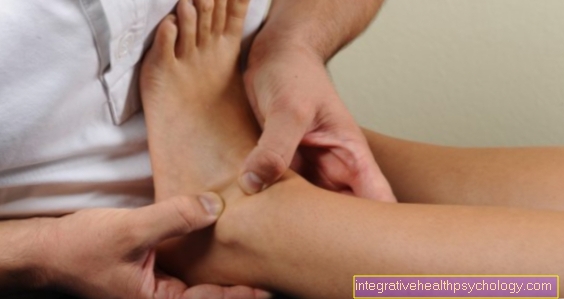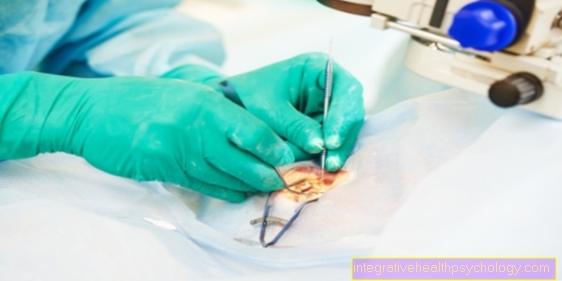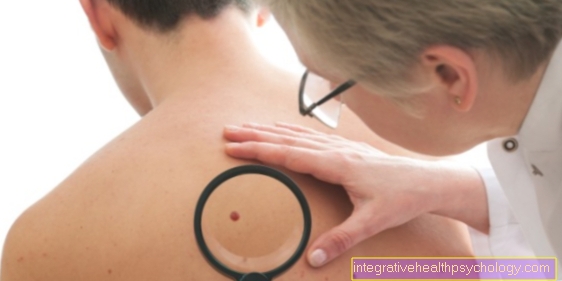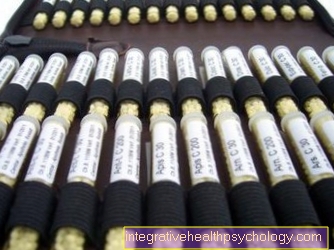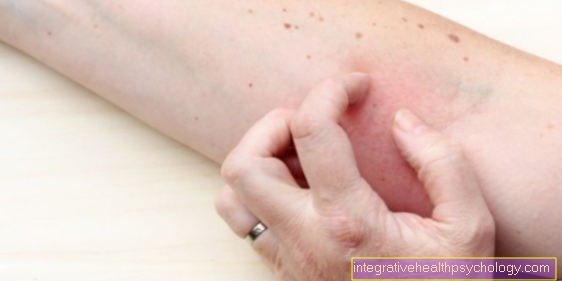Therapy of the lateral ankle fracture
introduction
The outer ankle fracture (Fibular fracture) can operative or conservative be treated. Which treatment is appropriate in each individual case depends on exactly where the fracture is and which structures are affected. Above all, it plays a role whether the Syndesmosis ("Tape adhesion") between the inner and outer ankle is also affected, and whether there are accompanying injuries.

Which lateral malleolus fracture can be treated conservatively?
A visible malaligned fracture of the outer ankle (displaced fractures) should be set up by the emergency doctor at the scene of the accident (repositioned) to avoid pressure damage to the soft tissues (Skin, nerves, vessels) by Bone parts to avoid.
There are basically two different methods available for treating a fracture of the outer malleolus: On the one hand, there is one operative restoration and fixation of the bone, on the other the so-called conservative treatment without surgical intervention.
The decision about conservative treatment of an external malleolus fracture depends on the extent of the injury. Open fractions or fractures where the fracture ends of the bones have slipped too far apart (displaced fractures), are called so-called. Weber B or C fractures classified and must be operated on. Against it can uncomplicated breakslocated below the Syndesmosis ("Tape adhesion"), (Classification type Weber A), as well as fractures in which the ends of the bones have not shifted against each other (undislocated fractures) can be treated without surgery (conservatively).
Even if there are so-called Contraindications, i.e. findings that speak against an operation, one often opts for conservative treatment. For example, these contraindications are significant Circulatory disorders in the operating areawhich would lead to significantly poorer wound healing. Such circulatory disorders can result from a pronounced peripheral arterial occlusive disease (PAD), one Diabetes mellitus or smoking. Unfortunately, there is often a combination of all of these factors that speak against surgery. Even if there is an increased risk of infection Leg ulcers ("Open legs") or an existing forefoot infection, to be on the safe side, the operation is often avoided. Even in very old patients, the risk of an operation must be carefully weighed against the potential benefit; Here too, the therapy is often rather conservative.
The conservative therapy of the outer malleolus fracture consists first of all of correcting the two ends of the fracture. That said, the ankle will be for the time being directed. Then the foot or outer ankle is covered with a so-called Airwalker splinted. Then one follows Immobilization and protection of the affected outer ankle for about six weeks so that the broken ends can grow together again in the correct position.
Conservative therapy for fracture of the lateral ankle
Conservative therapy of the lateral malleolus fracture is in principle possible in the case of non-displaced fractures and fractures without syndesmosis injury.
These include simple outer ankle fractures or inner ankle fractures below the Syndesmosis as well as non-displaced outer ankle fractures at the level of the Syndesmosis, provided this is not violated.
With a conservative treatment approach, the therapy consists of immobilizing the outer malleolus fracture by means of a plaster cast, for example, after any displaced bone parts have been brought back into their correct position. With this so-called Reduction a doctor correctly aligns pieces of bone that can be felt by hand. The result is checked with an X-ray examination in order to obtain an exact result. A split lower leg cast is used to immobilize the fracture.
With adequate pain therapy and so-called Thrombosis prophylaxis (Prevention of a blood clot) one should first wait until the affected lower leg is sufficiently swollen and healed. This usually takes about 3 weeks. Then the patient is allowed to put light weight on the affected leg again. Initially, however, only a so-called Partial load that means standing with your entire body weight on the broken leg should be avoided. With the help of adapted forearm crutches and regular physiotherapy, the load can be continuously increased within the second 3 weeks, depending on the patient's pain. After a total of 6 weeks, the outer malleolus fracture will usually have healed sufficiently under conservative treatment so that the cast can be removed. Until then and also afterwards, regular x-ray checks of the break are necessary in order to assess the position of the fragments on one another. In the event of subsequent slipping or shifting or sudden instability, an operation may still be necessary in the second step.
Overall, the conservative therapy of the lateral malleolus fracture is a relatively low-risk procedure. Possible dangers and complications can be pressure points caused by the plaster of paris on the skin and in the underlying tissue. A stiffening of the joint can unfortunately be observed every now and then, but in the vast majority of cases it can be remedied by appropriate physiotherapeutic measures. In some patients it can be caused by the long period of lying down Thrombosis (Clot that closes a vessel), which is why you usually get a drug from the start Thrombosis prophylaxis performs. Shortly after the plaster cast has been removed, the affected leg may also have restricted mobility, as both the bones and the muscles become less resilient as a result of being kept in the plaster for a long time. About 10% of patients also develop osteoarthritis (signs of wear and tear) of the affected ankle earlier than people who have never suffered a fracture of the outer ankle. Only very few people have a lifelong misalignment of the foot.
Read more on this topic: External ankle fracture without surgery
Appointment with ?

I would be happy to advise you!
Who am I?
My name is dr. Nicolas Gumpert. I am a specialist in orthopedics and the founder of .
Various television programs and print media report regularly about my work. On HR television you can see me every 6 weeks live on "Hallo Hessen".
But now enough is indicated ;-)
Athletes (joggers, soccer players, etc.) are particularly often affected by diseases of the foot. In some cases, the cause of the foot discomfort cannot be identified at first.
Therefore, the treatment of the foot (e.g. Achilles tendonitis, heel spurs, etc.) requires a lot of experience.
I focus on a wide variety of foot diseases.
The aim of every treatment is treatment without surgery with a complete recovery of performance.
Which therapy achieves the best results in the long term can only be determined after looking at all of the information (Examination, X-ray, ultrasound, MRI, etc.) be assessed.
You can find me in:
- Lumedis - your orthopedic surgeon
Kaiserstrasse 14
60311 Frankfurt am Main
Directly to the online appointment arrangement
Unfortunately, it is currently only possible to make an appointment with private health insurers. I hope for your understanding!
Further information about myself can be found at Dr. Nicolas Gumpert
Therapy with Airwalker for fracture of the lateral ankle
Under a Airwalker one understands a boot that is used for various foot injuries and also for the therapy of the lateral ankle fracture. The Airwalker is therefore an alternative to plaster of paris.
It consists of one Plastic shell. There is a in the boot Vacuum cushionthat adapts well to the shape of the patient's leg. Therefore, the external malleolus fracture can be stabilized well. Movement of the leg is possible because the Airwalker does a lot light is. He's still good air permeablewhich helps reduce swelling. Since the Airwalker too to decrease anytime the treating physician can assess the progress of the therapy of the lateral ankle fracture better than with a rigid cast.
The disadvantage is that the boot has to sit properly and with incorrect application no healing therapy but pain and a deterioration of the external ankle fracture can occur. Also, even if the Airwalker should have the option which offers simple and immediate loading, the outer ankle does not become overloaded too soon.
In some cases the Airwalker cannot be used as an alternative to plaster of paris for certain reasons. The attending physician decides whether the Airwalker is suitable for treating the fracture of the lateral ankle.
Operation for fracture of the lateral ankle
In the case of unstable or displaced fractions of the types Weber B and C, in which the ligamentous apparatus of the ankle was very likely or certainly also injured, as well as in so-called open fractures, in which one or more of the fragments protrude through the skin, surgical therapy of the outer malleolus fracture is absolutely necessary. Fractures that are associated with vascular or nerve injuries or that cannot be straightened externally by hand are also good reasons for surgical intervention. The same applies to external ankle injuries with considerable soft tissue damage, i.e. bruises or tears in the muscles and / or the subcutaneous fatty tissue in the affected area.
Surgical therapy of a fracture of the outer ankle can be carried out under general anesthesia, but also regional or so-called regional anesthesia procedures Nerve blocks or one Spinal anesthesia are possible in principle. The individual decision for or against a certain procedure is made by the patient according to his personal risk profile and his preferences together with an anesthetist.
The operation should then serve to reposition and fixate the fragments. The ligamentous apparatus and surrounding structures are also restored as precisely as possible. The anatomically correct restoration of the bone is carried out with the help of so-called Screw and / or plate osteosynthesis. This means bringing together and attaching various fragments with the help of screws or small metal plates. The plates are primarily used to permanently secure the bone or pieces of bone in a specific position. The screws fix the plate to the bone or two pieces of bone together. The most exact possible fitting of the fragments and firm compression are crucial for a good and quick healing process. For more complex fractures of the outer ankle or for patients suffering from osteoporosis, so-called wincestable plateswhich prevent the fixation from tilting after the surgical procedure thanks to a special toothing of the fastening screws inside the plate. In the course of the operation, the surgeon also examines and checks the ligamentous apparatus of the entire ankle - especially the so-called Syndesmosisin order to be able to safely rule out a possible co-injury. A suture or other fixation may be necessary here as well.
In any case, the surgical team will of course also treat other injuries in the area of the fracture. Damaged nerves are sewn as well as possibly torn blood vessels. In the case of large crush injuries or large skin wounds, this area must also be reconstructed in order to guarantee the patient an appropriate result visually. Once all structures have been straightened and fixed, the surgeon checks the stability of the ankle one more time. This is done on the one hand by manual examination, because the attending physician usually has a lot of experience with such injuries and can assess shifts well, and on the other hand with the help of special tests under X-ray control. If the ankle is still unstable despite the fracture being fixed, a so-called set screw is used in the last step of the operation. This screw connects the two bones of the lower leg (tibia and fibula) just above the ankle and keeps them at an optimal distance. This additional screw connection stabilizes the broken outer ankle. However, this does not have to be necessary in every case. Under special circumstances, the operation described above may not be possible temporarily or permanently. In these exceptional cases, the attending physician will suggest an alternative procedure and discuss this in detail with the patient.
More on the topic Read surgery for an external malleolus here.
Surgical treatment of an external malleolus fracture is carried out immediately as part of an emergency operation in the case of open fractures that pierce the skin or severe soft tissue damage that puts tension on the skin and the surrounding tissue. All other fractures to be operated on should be treated within 6-8 hours after the actual injury, if the swelling allows it. In the case of a very strong swelling of the tissue, decongestant measures and a so-called Thrombosis prophylaxis and an appropriate antibiotic therapy, the swelling must first be awaited. This can then be followed by the treatment described above as a planned operation.
Of course, this operation is not entirely free of risks and possible complications. Often there is a hematoma, i.e. a bruise, in the area of the surgical wound. Sometimes some skin and tissue parts die off, a so-called Wound necrosis. Since infections of the ankle or leg occur in around 2% of cases after surgery, regular monitoring by a doctor must be carried out during the course of the operation. Swelling and possible inflammation are assessed by looking at and touching the operating area. In addition, several x-ray checks are carried out to ensure that the Osteosynthesis to be checked and to recognize any subsequent slippage at an early stage. According to the surgeon's instructions, a dosed loading of the operated ankle can be started relatively early. The load is slowly built up with the help of a physiotherapist. As a rule, a full load is possible after about 6 weeks. However, if an adjusting screw has been used, it must be removed before starting the load. In most cases this happens after about 6 to 8 weeks. Only afterwards are training, gait training and other physiotherapeutic measures possible. Other screws and / or plates that were used for fixation can also be removed after the final bone healing is complete if the patient so wishes. This can be the case, for example, if older osteosyntheses are painful or restrict the movement. However, there is of course the risk of a new operation as well as the risk of a renewed breakage due to the removal of the implants.
Read more on the topic: Follow-up treatment for fracture of the lateral ankle


















